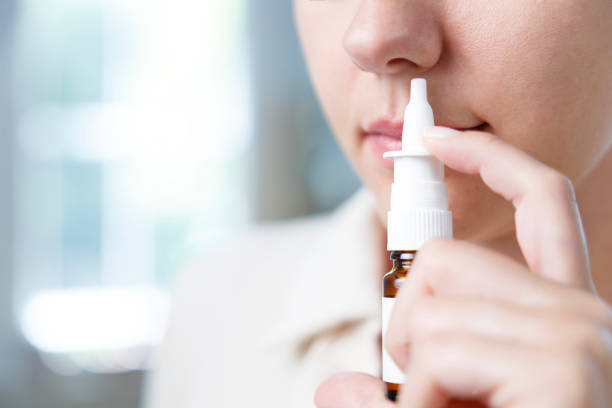USP Inhalation Product Emitted Dose Testing
The USP Inhalation Product Emitted Dose Testing is a critical procedure that ensures the accuracy and reliability of dosage delivered from inhalation products, including nasal sprays. This testing is essential for pharmaceutical manufacturers to ensure their products meet stringent quality standards set forth by the United States Pharmacopeia (USP).
The emitted dose test evaluates the amount of active ingredient or medication released into the air during actuation. The primary goal is to verify that the product delivers the intended therapeutic effect consistently and safely, which is crucial for patient safety.
This testing typically involves a series of steps: specimen preparation, device actuation under controlled conditions, collection of emitted particles using specialized sampling techniques, and subsequent analysis in accordance with USP guidelines. The collected data is then used to determine the emitted dose percentage, ensuring compliance with the relevant sections of the USP.
The test setup includes an aerosol generator that simulates the actuation process of inhalation devices, along with particle collection equipment such as impactors or filtration systems. The particles are analyzed using techniques like scanning electron microscopy (SEM) and energy-dispersive X-ray spectroscopy (EDX). This multi-step approach ensures accurate quantification of the emitted dose.
Compliance with USP standards is mandatory for pharmaceutical companies, particularly those targeting the North American market. Failure to meet these criteria can result in product recalls or even legal action. Therefore, it is imperative that manufacturers invest in robust testing protocols and state-of-the-art equipment to ensure consistent quality and performance.
The emitted dose test is not only a measure of safety but also an indicator of efficacy. By ensuring the correct amount of medication reaches the intended target area, the test helps minimize side effects while maximizing therapeutic benefits. This is particularly important for nasal sprays where improper dosing can lead to ineffective treatment or undesirable outcomes.
The process involves careful calibration and validation of testing equipment, adherence to strict procedural guidelines, and meticulous record-keeping. These measures ensure that each test is reproducible and reliable, providing manufacturers with a clear picture of their product's performance.
| Test Parameter | Description |
|---|---|
| Aerosol Generation | The process of creating an aerosol from the inhalation device under controlled conditions. |
| Particle Collection | The method used to capture and analyze emitted particles for accurate dose measurement. |
| Analytical Techniques | Techniques employed for the quantification of active ingredients in collected samples. |
Industry Applications
The USP Inhalation Product Emitted Dose Testing finds application across various sectors within the pharmaceutical industry, particularly in nasal sprays and inhalers. This testing is vital for ensuring that these products deliver the correct dose of medication, thereby enhancing patient safety and efficacy.
- Nasal Sprays: Ensures consistent delivery of active ingredients directly into the nasal passages for immediate absorption.
- Inhalers: Verifies that the device delivers the correct amount of medication to the lungs, optimizing therapeutic outcomes.
The test is also crucial in developmental stages where manufacturers are fine-tuning their formulations. By testing at various points during development, companies can identify potential issues early and make necessary adjustments to improve product performance.
This testing is particularly important for new entrants into the market who must demonstrate compliance with USP standards before gaining regulatory approval. It also benefits established brands looking to maintain high-quality standards and differentiate themselves in a competitive market.
International Acceptance and Recognition
The USP Inhalation Product Emitted Dose Testing is widely recognized not only within the United States but also internationally. The USP standards are often adopted as a benchmark for quality assurance in pharmaceutical testing, making this service particularly valuable for multinational companies.
Many countries outside the US have either adopted or aligned their own national pharmacopeias with the USP guidelines. This alignment ensures that products manufactured under these standards can be easily exported and sold globally. For instance, many European Union member states use EU harmonized pharmacopoeia, which closely follows the USP.
The recognition of USP testing also extends to regulatory bodies worldwide. Agencies such as the World Health Organization (WHO) and the International Conference on Harmonisation (ICH) often recommend or require compliance with USP standards. This global acceptance enhances market access for pharmaceutical companies, making emitted dose testing a strategic advantage.
Additionally, the use of USP standards in testing helps streamline regulatory processes across different countries, reducing time-to-market and operational costs for manufacturers. The consistent application of these tests ensures that products meet international quality benchmarks, fostering trust among consumers and healthcare professionals.
Environmental and Sustainability Contributions
- Emissions Control: By ensuring the correct amount of medication is delivered, this testing helps minimize waste and reduce environmental impact.
- Eco-friendly Ingredients: The use of biodegradable materials in packaging can further enhance sustainability efforts.
The USP Inhalation Product Emitted Dose Testing not only ensures product efficacy but also promotes responsible manufacturing practices. By minimizing the amount of medication that does not reach its intended target, manufacturers can reduce unnecessary emissions and lower overall environmental footprint.
Moreover, the use of biodegradable packaging materials in conjunction with this testing supports sustainable development goals. These materials decompose naturally without contributing to pollution or waste accumulation, aligning pharmaceutical companies with broader sustainability initiatives.





